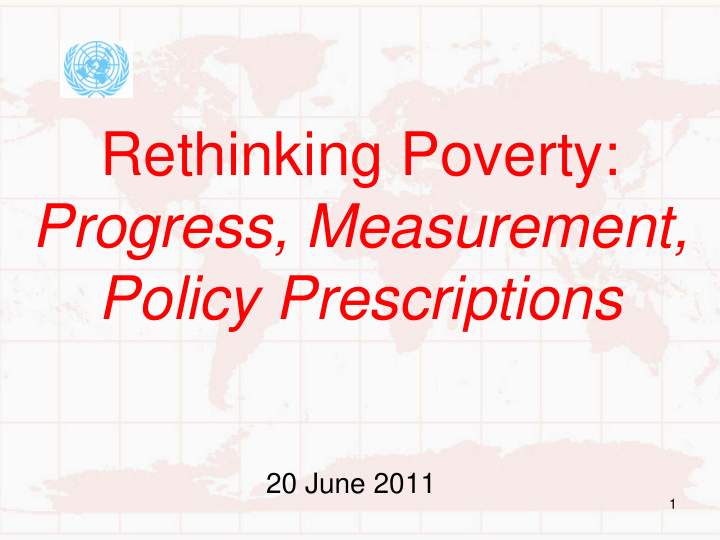



Rethinking Poverty: Progress, Measurement, Policy Prescriptions 20 June 2011 1
MDG 1: Halve Poverty, Hunger Progress on poverty reduction uneven, threatened, but achievable • WB’s $1/day poverty line: 1.4bn people living in extreme poverty in 2005, down from 1.8bn in 1990 • But without China, no. of poor actually went up over 1990-2005 by @ 36m • 92m more poor in SSA over 1990- 2 2005
Money measures Poverty mostly measured in money terms: per capita or household income or spending Extreme poverty – those living on less than US$1/day (in 1993 prices) Using this measure, global extreme poverty has become less severe over last two decades, but with significant regional variation
Changing definition WB $1/day line probably under-estimates actual extent of poverty (Townsend): – Shifting goalposts: $1.25/day based on average poverty line of poorest 15 countries – different from earlier definitions Income or spending yardstick does not tell whole story 1995 World Social Summit poverty definition considers deprivation, social exclusion and lack of participation if so, poverty situation graver (Townsend)
Poverty line sensitive . . POVERTY POVERTY LINE POVERTY LINE POVERTY MILLIONS LINE Equivalent Equivalent HEADCOUNT OF PEOPLE US$ per US$ per (% population BELOW Rupiah per person/day person/month below poverty POVERTY person/month line) LINE 0.27 8.38 62,870 9.75 22.0 0.29 8.80 66,021 12.10 26.1 0.30 9.22 69,165 14.55 31.4 0.32 9.64 72,309 17.40 37.6 0.33 10.06 75,452 20.18 43.6 0.34 10.47 78,596 23.03 49.7
Poverty line lowered? • Poverty line catchy, convenient, but misleading • New WB $1.25/day line (2005 PPP) earlier: $1.08/day (1993 PPP) original: $1/day • If US inflation considered, line would be $1.45 in 2005, NOT $1.25 But Bhalla unfair (“WB exaggerates poverty to keep itself in business”)
Not enough food? • Poverty line mainly defined as money income to avoid hunger, but huge discrepancies between poverty + hunger measures • FAO: 963m. hungry world-wide – up by 142m. since 1990-92 • Attributed to changing definition, faulty methodology
WB estimates • No. of poor fell from 1.9bn in 1981 to 1,399m. in 2005: >40% increase over earlier 986m. (“bottom billion”) for 2004! • From 52.0% to 25.7% of world population • But if China left out, global extreme poverty number higher • Without China, extreme poor up from 1.1bn in 1981 to 1.2bn in 2005
Where are the poor? • Highest share of poor changed from E Asia to S Asia + SS Africa 57% of world’s extreme poor lived in E Asia + Pacific in 1981, down to 23% in 2005 S Asia share increased from 29% in 1981 to 43% in 2005 SS Africa share more than doubled from 11% to 28% in this period
Market liberalization? • Economic liberalization since 1980s - slowed growth, poverty reduction - increased inequality, vulnerability + volatility in most countries • Slower growth (except 2003-2008) • Reduced policy space • Less growth + revenue -- due to liberalization, tax competition -- have reduced fiscal means • Reduced policy + fiscal space adverse effects for poverty + destitution
Poverty magic bullets No evidence of IFI/donor favoured special poverty programs significantly reducing poverty without sustained growth + job creation, e.g. -- good governance -- micro-credit -- property rights (e.g. land titling) -- ‘bottom of the pyramid’ marketing
Governance • ‘Good governance’ indicators reflect development status – not prerequisite for development • Most developing countries do not have fiscal means for comprehensive ‘good governance’ reform • Market failures likely to remain • ‘Pro-poor’ governance reforms claim to improve service delivery to poor. But neither theory nor evidence support this • Instead, focus on ‘good enough’ alternative development-enhancing governance capabilities to address “key” development bottlenecks
Thank you Report on the World Social Situation 2010 Please also visit UN-DESA esa.un.org/ Jomo K. S. & Anis Chowdhury (eds) . Poor Poverty: The impoverishment of its analysis, measurement and policies. Bloomsbury. National Development Strategies Policy Notes World Economic and Social Survey DESA working papers IDEAs website: www.ideaswebsite.org 13
Recommend
More recommend